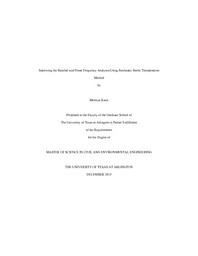
ATTENTION: The works hosted here are being migrated to a new repository that will consolidate resources, improve discoverability, and better show UTA's research impact on the global community. We will update authors as the migration progresses. Please see MavMatrix for more information.
Show simple item record
| dc.contributor.advisor | Fang, Nick Z. | |
| dc.creator | Kiani, Morteza | |
| dc.date.accessioned | 2017-03-23T15:03:28Z | |
| dc.date.available | 2017-03-23T15:03:28Z | |
| dc.date.created | 2015-12 | |
| dc.date.issued | 2015-12-14 | |
| dc.date.submitted | December 2015 | |
| dc.identifier.uri | http://hdl.handle.net/10106/26512 | |
| dc.description.abstract | Reproduction and realization of historical rainfall events provides foundations for flood and rainfall frequency analyses and the advancement of meteorological studies. Stochastic storm transposition (SST) is a method for such a purpose and enables us to perform frequency analyses by transposing observed historical storm events over any given watershed. The goal of this study is to stochastically examine the impacts of extreme events on all locations in a homogeneity zone. Storms with the same probability of occurrence on a defined homogenous neighborhood will generate various impacts due to spatial and temporal variations of the storms. Transposing storms occurring in the homogeneity zone will improve our understanding based on any probable rainfall event. This procedure is iterated thousands of times to simulate less frequent storm events over a watershed as the basis to update frequency curves such as the intensity duration frequency (IDF) and flood frequency analysis (FFA). Thousands of storm realizations were utilized along the semi-distributed rainfall-runoff model with low run time enabling the SST to embrace thousands of possible events. A unique characteristic of this study is that applying the SST to a well-defined and commonly used hydrologic model changes the SST method from a theoretical approach to an applied method for frequency analysis. This study focuses on one of the subbasins in the Upper Trinity River watershed, the Mary’s Creek River Basin within the Dallas-Fort Worth metroplex. This watershed has a total area of 53 square miles. Ten years of NEXRAD radar rainfall data were used in this study to examine the precipitation and flood frequency curves and a semi-distributed rainfall-runoff model was coupled with a multi-sensor precipitation estimator (MPE) to create thousands of storm realizations. We used an innovative approach in storm selection to ensure the inclusion of those events that produce high rainfall depth over the study area. The SST approach was successfully used to extend the existing data set temporally and spatially. IDF results from the SST data were compared with other sources such as USGS/TxDOT and iSWM. Results showed that for rainfall with one-hour durations, rainfall intensity from TxDOT/USGS and iSWM IDF curves were consistently higher than SST results at all subbasins. The opposite trend was observed for all other rainfall durations. The FFA results indicate that the design storms (5-year, 10-year, 25-year, 50-year, 100-year, and 200-year) have considerable overestimation at subbbasins with low drainage contributing area compared to the corresponding SST results. The SST and design storms results are similar at downstream locations. As a final objective, we used the SST approach to understand the relationship between return periods of rainfall and discharge information. The results imply that the regional IDF information is subject to large uncertainties due to low correlation between return periods of discharge and rainfall. | |
| dc.format.mimetype | application/pdf | |
| dc.language.iso | en_US | |
| dc.subject | Stochastic storm transposition | |
| dc.subject | Radar-rainfall data | |
| dc.subject | Flood frequency analysis | |
| dc.subject | Rainfall frequency analysis | |
| dc.title | Improving the Rainfall and Flood Frequency Analyses Using Stochastic Storm Transposition Method | |
| dc.type | Thesis | |
| dc.date.updated | 2017-03-23T15:03:28Z | |
| thesis.degree.department | Civil Engineering | |
| thesis.degree.grantor | The University of Texas at Arlington | |
| thesis.degree.level | Masters | |
| thesis.degree.name | Master of Science in Civil Engineering | |
| dc.type.material | text | |
| dc.creator.orcid | 0000-0001-5841-4028 | |
Files in this item
- Name:
- KIANI-THESIS-2015.pdf
- Size:
- 10.38Mb
- Format:
- PDF
This item appears in the following Collection(s)
Show simple item record


